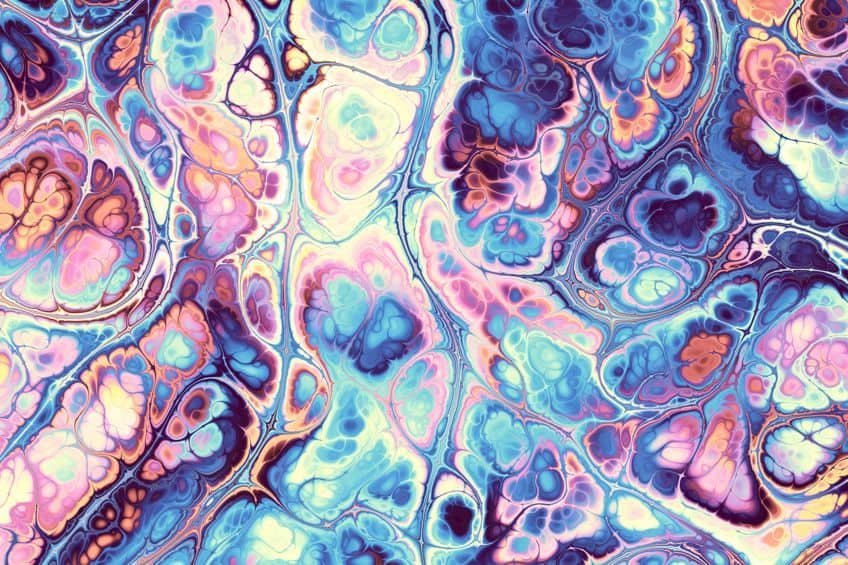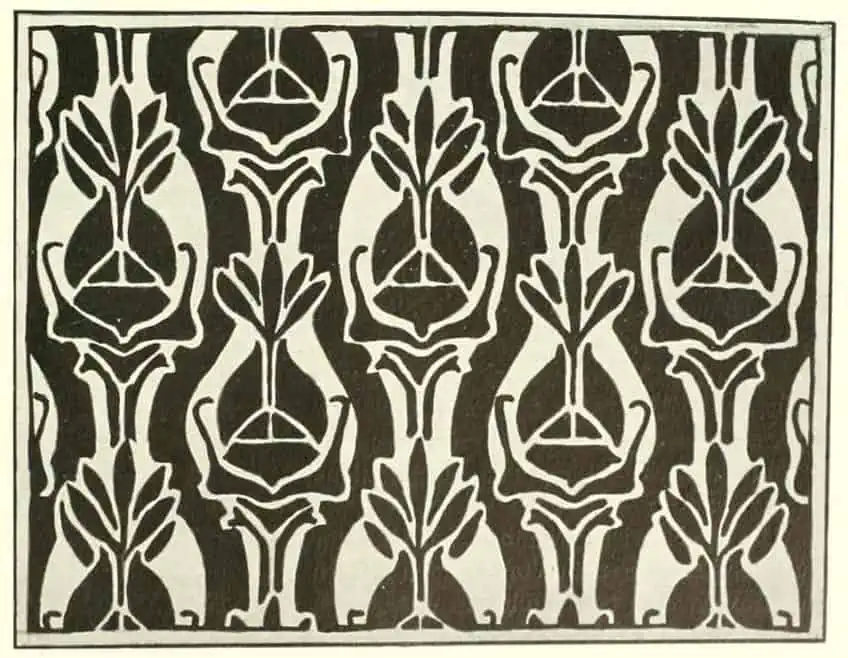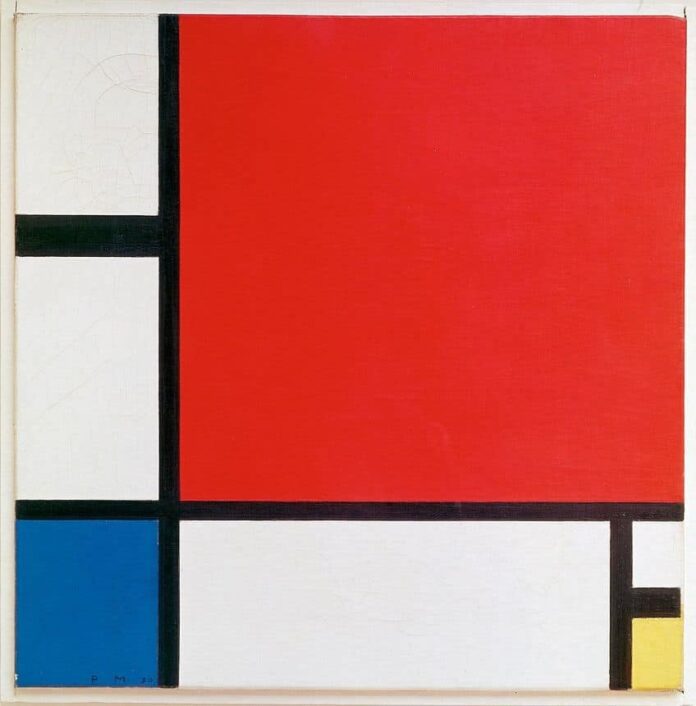By Charlene Lewis
What do you think when considering patterns? Maybe you are thinking of floral wallpaper, or that Turkish rug that you have at home. However, there are many different types of patterns in art, whether it is a beautiful painting or a designer outfit. In this article, we will be focusing on art patterns, what they are, the different types of patterns in artwork, and how to use them. We will also be including a few examples below. Read on to find out everything there is to know about patterns in art!
What Are Patterns in Artwork?
A pattern is a repetition of some form of visual element, usually arranged in a certain fashion that produces a harmonious look, which is why we all are drawn to patterns. Artists can use these art patterns as a composition for their work, simply as decoration, or may make an entire art piece out of patterns. Patterns in art are useful, as they help to catch your eye and be the main feature. However, art patterns can also be a subtle inclusion and are usually created by using color, lines, form, and shape.

Recognizing patterns in something that is built into our brains helps us understand our environment. This is why patterns are something that attracts and intrigues us, whether the pattern is obvious, or even more so, when you have to take a closer look. Patterns provide a certain rhythm and movement to art, but they do not always have to be identical patterns. Patterns in art also convey a sense of harmony and balance. Where do artists get their inspiration? Patterns are everywhere, they can be seen all around us. For example, think of waves, sand dunes, or flowers, and those are just a few of the patterns found in nature. Many of these patterns can be modeled mathematically, like spirals, which have often been used in various artworks.
However, before we get into any examples of patterns in art, let us first have a look at the types of patterns in art.
Different Types of Patterns in Art
If you have to divide the various art patterns, you can place them into two main types of patterns in art. These would include your natural patterns found in nature and man-made patterns. Both of these can then also include irregular and regular patterns and geometric or organic patterns. These patterns can also be random or can form a repeating pattern.

Natural Patterns
These patterns can be found all over our natural environment. There are many examples of patterns in nature, from leopard spots to the smallest molecular arrangements and massive patterns like the one in our very own Milky Way galaxy. Many of the patterns are regular, but some might appear irregular but are consistent. In other words, natural patterns are organic and can be irregular but are never random. For example, a snowflake has a six-sided shape or hexagonal structure, but each snowflake has a unique pattern.
Other patterns can be irregular, but come in different shapes and sizes, for example, a rocky beach, where all the rocks are varying sizes and face in different directions.
There are patterns in leaves, flowers, and even in our bodies. Many of these patterns are used for different reasons, such as camouflage or protection. Many patterns in nature might have a purpose, but for us, a lot of patterns are simply just beautiful to look at. For example, the different patterns on butterfly wings, or an intricate spider web with dewdrops. Some patterns are even governed by mathematics, for example, the “Golden Ratio”. This ratio or mathematical rule describes certain patterns that have symmetry, like spirals, and can be found in shells or flowers, among other places. There are often repeating patterns in nature that include colors, lines, and shapes. The main classifications for these repeating patterns include some of the following.
- Fractals: This can also be described as branching, a pattern that keeps repeating in different sizes and directions. For example, blood vessels, fern leaves, branches of a river, or trees.
- Line patterns: These are linear and sometimes also refer to cracks or stripes. For example, stripes on a zebra.
- Meanderings: This pattern’s dominant feature is curved lines. For example, think of a snake or meandering river.
- Foam or bubbles: A pattern of repeating spheres that can be one or many.
- Waves: Wave patterns can be seen in bodies of water, and some cannot be seen but can be recorded, for example, sound waves.

Man-Made Patterns
These types of patterns are created by humans and can be used for both decorative and structural purposes. These patterns can be used in many different forms, including paintings, sculptures, architectural designs, textiles, and other decorative arts and crafts. You can find different man-made patterns in different forms all around the globe that come from different cultures. Consider the geometric shapes of Islamic motifs or African dress, and bead patterns. You might also find that each culture has particular patterns in architecture, textiles, and other objects.
Other more general examples of man-made patterns include some of the following.
- Spiral staircases
- Bricks or tiles
- Windows in a building
- Patterned rugs
- Layout of a housing or city block

Geometric Patterns
Geometric patterns can be found in both natural and man-made patterns. These types of patterns can refer to paintings, shapes, objects, images, or an element that repeats itself regularly or irregularly. The patterns are usually bold in color and shape, have clean lines, and can usually be based on certain math principles. Some shapes that are commonly found in geometric patterns include:
- Circles
- Squares
- Ovals
- Star shapes
- Triangles
- Diamond shapes
- Hexagons
- Octagons
- Pentagons
Consider concentric circles, where can you find them in nature? The more common places are tree stumps, onions, or discovering what happens when you throw a pebble in some water. Other examples are salt granules, spider webs, honeycombs, pinecones, and snowflakes. Man-made geometric shapes are used for various purposes, from creating beautiful designs that can be used on clothing or in building designs, or simple designs as you can find on a checkerboard.
Below are a few geometric patterns artists use in different ways.
- Tessellation: Also known as “tiling”, This pattern incorporates the same geometric shape over and over and covers an entire plane with no gaps.
- Isometric patterns: This pattern is used to form a three-dimensional figure on a two-dimensional plane.
- Low poly patterns: One of the more modern patterns, using simple shapes and colors, in particular, a collection of polygons, which creates an angular and minimalistic effect, often used in computer graphics.

Irregular Patterns
When we think of patterns, we tend to expect something that is “perfect”, especially some man-made designs. Our minds naturally recognize and find patterns soothing. Again, think of a checkerboard, it has contrasting squares in specific colors, with straight lines. We all recognize this pattern, so what if one square is purple instead of black or white?
You will immediately be drawn to this “anomaly” as it is unexpected and irregular.
Artists use this to create irregular patterns for this very purpose. Irregular patterns also form a composition that is more energetic and can even convey a sense of chaos. Regular patterns are calmer and have more of a formal and structured feel that produces a sense of order. Irregular patterns can be formed in various ways, for example:
- Irregular shapes that are positioned differently and come in different sizes.
- Irregular objects, for example, a bunch of stones or rocks will provide an organic and rough look.
- Irregular directions, for example, the lines following a tree branching.
- Irregular colors and random colors create something that still works cohesively.
- Irregular images, where images can be different but still form a recognizable pattern.

How Do Artists Use Art Patterns?
Patterns in artwork are used to create decorations, however, patterns are also used as a method for creating compositions and patterns can be used as an entire art piece. Many different types of patterns in art are used to attract attention. Patterns in art also fall into what is referred to as the seven principles of art. These principles or rules help an artist create pleasing compositions for paintings and other forms of art.
Besides patterns, there are other principles of art, including the following.
- Balance: Using the elements to create visual balance within the composition.
- Harmony: Again, this is using the elements to create artwork that comes together cohesively.
- Rhythm: The movement within an art piece, and how your eye travels through the composition.
- Unity: How all the separate parts within a composition work together.
- Emphasis: The main focal point or focus of the artwork that attracts your attention.
- Contrast: When using opposing elements with a composition to create an appealing look.
- Movement: Physically representing movement within the artwork.
- Variety: Using different colors, and shapes, among other things to create diversity and interest.
- Proportion: The dimensions of a composition, refer to the depth, width, and height.
- Scale: The size of an object when you compare it to another object.
Elements of Art
The principles are what represent how an artist uses the elements or stylistic and visual features in art. Any good artwork piece will contain these seven elements. Some of the more notable elements include the following.
- Line: Lines can be created in different lengths, and widths, and can go in any direction. Lines are commonly used to define the edges of a form.
- Shape: The lines or contours of a shape, and is flat and two-dimensional, and contains width and height.
- Color: All colors or hues that also possess value and intensity.
- Form: An element that is three-dimensional and has height, width, and depth.
- Texture: How things feel in an art piece, for example, ridges, bumps, or grooves.
- Value: This refers to the darkness and lightness or brightness of an art piece.
- Space: The area above, around, and also within an object. Some examples of types of space include negative space, positive space, and three-dimensional space.

Why Use Patterns in Art?
Patterns are used in art because they provide movement as well as rhythm to an art piece. The patterns also help to capture a viewer’s attention and can also provide balance to the entire composition. Patterns are also fun to look at and are an intriguing way to experiment with the elements of art, for example, line, shape, and color. Creating patterns is a way an artist can convey a meaning or an emotion in the art piece.
Patterns are also used if you want to create something that has repetitive elements.
How to Form Patterns in Artwork
There are many methods of forming patterns in art. Many artists use patterns to create the basic structure of the art piece using lines and shapes, and then use other visual elements like color, texture, and tone across the whole art piece. Sometimes, less is more, and subtle patterns can create a more effective look. When using patterns, always make sure that the patterns form a cohesive look and fit with the rest of the painting. Often, you can find patterns that already exist in your subject, find these, and then exaggerate them, but make sure it looks natural.

The patterns can also be the main feature of an art piece. Most artists also tend to follow patterns throughout their work, which can become a recognizable signature style. Some of the following methods are used to create patterns in art.
Repeating Shape and Form
Artists use shape and form to create many ideas and artworks. Shapes can include circles, triangles, squares, and more. Forms are shapes with three-dimensional features, for example, cubes. Forms can also be figurative. A simple idea of a repeated shape is a single-color background with white circles repeated over and over at a standard distance from each other. Something that is often seen in gift wrapping paper.
An example of a more famous artist using this technique, then Andy Warhol is a popular choice.
Marilyn Diptych (1962) by Andy Warhol
| Artist | Andy Warhol (1928 – 1987) |
| Title | Marilyn Diptych |
| Date Completed | 1962 |
| Medium | Silkscreen painting |
| Size (cm) | 205.44 × 289.56 |
| Gallery | Tate Gallery, London, United Kingdom |
Andy Warhol was an American artist, famous for his silkscreen paintings, which were inspired by pop culture. He also produced other works across a range of media including paintings, photography, film, and music. He produced famous portraits of celebrities, such as Marilyn Monroe as well as Elvis Presley, among a few other well-known names. He often repeated his image within the same piece, using various colors. Other similar examples of his work include the repetitive image of soup cans, dollar bills, and soda bottles.
Patterns in Color
Color patterns can range from multicolor combinations to monochromatic designs. The colors can also be arranged in such a manner as to create form. Colors have meaning, so the chosen color palette can help to convey certain emotions and ideas, or the colors can simply be used for aesthetic reasons.
Below is an example of using only colors to create an art piece.
Orange and Yellow (1956) by Mark Rothko
| Artist | Mark Rothko (1903 – 1970) |
| Title | Orange and Yellow |
| Date Completed | 1956 |
| Medium | Oil on canvas |
| Size (cm) | 231.14 x 180.34 |
| Gallery | Albright-Knox Art Gallery, Buffalo, New York, United States |
Mark Rothko was a Latvian-born American, who is well-known for his abstract art, and the colors he used to evoke certain emotions. His paintings usually included large fields of unbroken color that produced a sense of limitlessness. His painting, Orange and Yellow (1956), which contains large sections of rectangular color, can be interpreted as a symbol of happiness and enjoyment.
Patterns in Line
Lines form a pattern according to how they are used within an art piece. Lines used in the art are very versatile and can be used vertically, horizontally, curved, diagonally, and wavy, among others. You can then create a whole lot of variations, taking into consideration the size, direction, texture, style, width, and length, among other factors.
To mention only a few uses and types of lines, there are contour lines that form a continuous line that outlines a shape, and cross-hatching or parallel lines that create patterns, texture, and volume.
Using lines in patterns can also be used to convey certain feelings, from more peaceful images to something energetic. The patterns created can be a mixture of different types of lines, which can also be used to create optical illusions. An example of a well-known artist using patterns this way is Victor Vasarely, who used lines and manipulated them to create images that have the illusion of movement and depth.
Zebra (1937) by Victor Vasarely
| Artist | Victor Vasarely (1906 – 1997) |
| Title | Zebra |
| Date Completed | 1937 |
| Medium | Screenprint |
| Size (cm) | 52 x 60 cm |
| Gallery | Sold at auction |
Victor Vasarely was a Hungarian-French artist and is considered the “grandfather” of optical illusion art. He studied the use of lines as well as creating perspective and the relation between light and dark. The work, known as Zebra (1937), was one of the first of many similar art pieces. The work displays two zebras that are intertwined and were created using white and black lines to form the shapes. The optical illusion produces a sense of movement. An interesting fact about Vasarely is that he was hired by Renault, the car manufacturing company, to redesign their logo.
More Examples of Patterns in Art
There are many examples of patterns in artwork, too many to provide an example of each. So, below are only a few thoughts on the matter, just so you can get a basic idea of how patterns are used in art.

The Starry Night (1889) by Vincent van Gogh
| Artist | Vincent van Gogh (1853 – 1890) |
| Title | The Starry Night |
| Date Completed | 1889 |
| Medium | Oil paint |
| Size (cm) | 74 x 92 |
| Gallery | The Museum of Modern Art, New York City, United States |
Vincent van Gogh was a Dutch painter that produced many Post-Impressionist paintings and remains one of the most influential figures in art. The painting The Starry Night (1889), is one of his more popular works and displays an impressive use of lines and patterns. Circular patterns were used to paint the night sky, which is also filled with swirling clouds.
The whole effect seems to lead the eye and highlights the use of movement.

The Kiss (1907 – 1908) by Gustav Klimt
| Artist | Gustav Klimt (1862 – 1918) |
| Title | The Kiss |
| Date Completed | 1907 – 1908 |
| Medium | Oil paint and gold leaf |
| Size (cm) | 180 x 180 |
| Gallery | Austrian Gallery Belvedere, Vienna, Austria |
Gustav Klimt was an artist from Austria and is well-known for his decorative art and symbolism. One of his more famous paintings known as The Kiss (1907–1908), depicts a whole range of different shapes that are arranged in patterns. You will observe two figures that are embracing in a field of flowers. The male figure is represented by a repeating rectangle pattern, while the female figure is made of circles.
The painting is a representation of a man and a woman coming together with the earth and the cosmos while being guided by love.

Composition with Red Blue and Yellow (1930) by Piet Mondrian
| Artist | Piet Mondrian (1872 – 1944) |
| Title | Composition with Red Blue and Yellow |
| Date Completed | 1930 |
| Medium | Oil on canvas |
| Size (cm) | 45 x 45 |
| Gallery | Kunsthaus Zürich, Zürich, Switzerland |
Piet Mondrian was a Dutch painter, who produced some well-known abstract art pieces. He often used irregular colors, shapes, and patterns to create an asymmetrical balance. One of his more famous paintings is the Composition with Red, black, blue, and Yellow (1930), which forms an irregular pattern, using lines, different shapes, and colors to create an irregular composition that provides a sense of repetition, which creates a visually appealing painting.

You cannot create art without using patterns, which is one of the main principles of art. Used together with the other principles and elements of art, you can create anything you wish. Patterns are not just something you find on your duvet cover; they play an important role in our everyday lives. So, the next time you gaze into a field of flowers, down a city street, or at a beautiful painting, see if you can find the different art patterns.
Frequently Asked Questions
What Are Patterns in Art?
Art patterns refer to a visual collection of certain elements that use repetition to create the pattern. For example, in nature, you have a line of trees or petals on a flower. Examples of man-made art patterns include bricks that form a pathway, a chessboard, and various architectural designs that are used for decorative or structural purposes.
What Are the Elements of Art That Help to Form Patterns?
Elements of art include lines, color, texture, shape, and form, among others. Repetition of these elements creates a design. A pattern is, therefore, a repetition and combination of these elements.
What Is the Purpose of Art Patterns?
The main use of art patterns is that they help to create balance and order in a design. Patterns can also be used to create movement and rhythm, as well as to emphasize various elements, among other things.
Source: https://acrylgiessen.com




